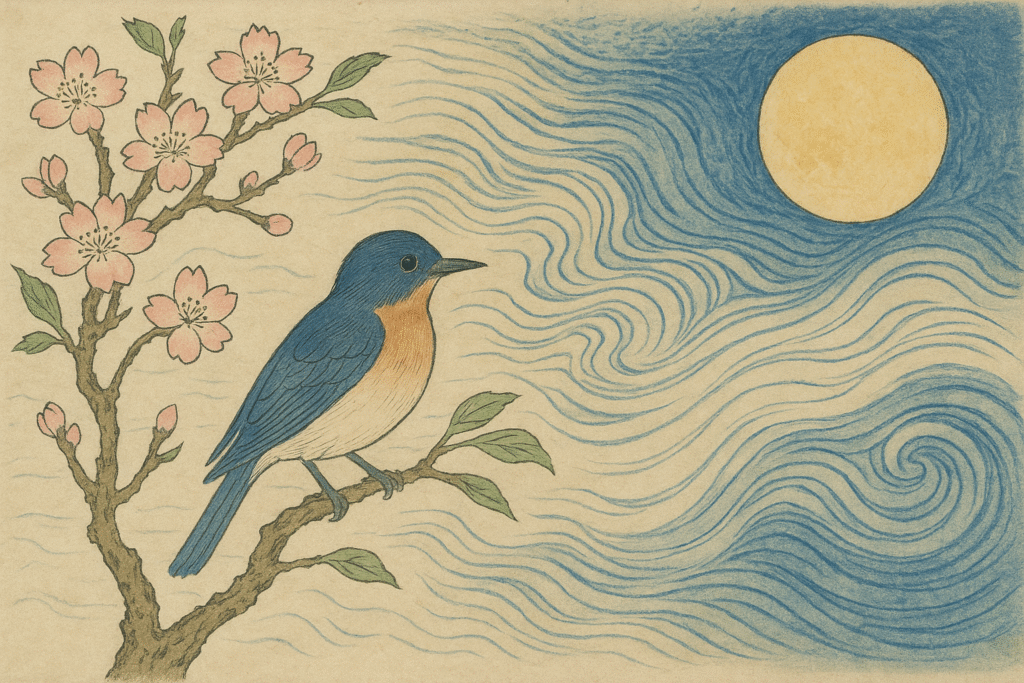Kachōfūgetsu: Japan’s Ancient Guide to Beauty in Life

The other day, while sorting through old travel photos and notes from my business trips to Japan, I stumbled across a small phrase I had jotted down in the margin of a notebook: Kachōfūgetsu (花鳥風月). Flower, Bird, Wind, and Moon.
At that moment, it was as if the memories came rushing back in color and sound — the hush of a Kyoto temple garden at dawn, the delicate scent of plum blossoms drifting through the air, the flicker of lantern light on a breezy Tokyo evening. I realized how much this timeless Japanese expression had quietly framed my experiences of the country, even if I hadn’t been fully aware of it then.

The Philosophy Behind Kachōfūgetsu
More than just four natural elements, Kachōfūgetsu is an invitation: to seek beauty in the ordinary, to pay attention to what each season offers, to let the rhythms of nature teach us about the rhythms of life. In Japan, this way of seeing isn’t reserved for poets and painters alone — it’s infused into daily life, from the seasonal menus at a humble noodle shop to the evening strolls of families beneath a full autumn moon.
Flower (花 – Hana): Fleeting Blossoms
When I think of hana, my mind immediately drifts to cherry blossoms. I remember sitting under a canopy of sakura in Ueno Park, surrounded by families, students, and colleagues — all gathered for hanami (flower viewing). I was able to visit only once, and that too towards the end. The petals drifted down like pink snow, coating the benches and walkways. For a brief week, the entire city seemed softer, lighter, as though time itself slowed down to honor the fleeting bloom.
And then, just as quickly, the blossoms vanished — carried away by the spring winds. In that disappearance lay the beauty: a reminder that life’s most precious moments cannot be stored away, only savored while they last.
Bird (鳥 – Tori): Songs of Freedom
Birds in Japan often carry layers of meaning. Cranes, symbols of longevity and peace, appeared not only in temple art but also in origami folded with quiet care at tea houses. I remember waking up one morning in the small town of and greeted by sound of sparrows chattering as we headed to the train station. Their song felt like a morning blessing, a simple soundtrack to life’s renewal.
In Tokyo’s, one can often hear crows cawed loudly over the heads of joggers near and office workers. Even here, amid skyscrapers and subways, the presence of birds grounded me in the knowledge that nature endures, no matter how fast human life moves.
Wind (風 – Kaze): Invisible, Ever-Changing
The wind in Japan seemed to have its own voice. In summer, the clinking of furin (glass wind chimes) hung outside homes turned the breeze into music. Walking through narrow Kyoto streets at dusk, I would pause to listen to their soft, crystalline notes mingling with the cicadas’ chorus.
I remember standing on the shore at Kamakura, the ocean winds whipping against me, as surfers danced on the waves beneath the watchful gaze of the Great Buddha. That wind carried more than air — it carried a reminder of change, of impermanence, of how we are shaped by what we cannot see.
Moon (月 – Tsuki): A Gentle Witness
The Japanese moon has a quiet way of making itself unforgettable. In autumn, the tradition of tsukimi — moon-viewing — transforms an ordinary night into a celebration. My colleagues would tell me that the families sit together on porches, sharing seasonal foods like taro or dumplings, gazing up at the luminous orb.
I once found myself on a late train from Osaka, the car half-empty, when I glanced out the window riding back from a customer meeting and saw the moon reflected on a river’s surface. The sight was fleeting — the train rushed past — but the image stayed with me. In that quiet moment, I understood why the moon has inspired so much poetry: it connects us not just to nature, but to the passage of time itself. In fact my earliest photography experiments were also capturing the moon.
What Kachōfūgetsu Taught Me
Looking back, I realize that Kachōfūgetsu was not just a phrase I learned in passing, but a lens through which I experienced Japan. It was there in the way people paused to admire a cluster of blossoms, in the seasonal flavors woven into meals, in the way a gust of wind or a full moon became part of daily conversation.
My business trips often carried me through the intensity of meetings, presentations, and deadlines. Yet outside the conference rooms, Japan offered me a slower rhythm — one where noticing a bird’s song, the fragrance of a flower, or the glow of the moon was not indulgence, but wisdom.
Kachōfūgetsu reminds us that true beauty isn’t in possession but in perception. It whispers that life’s meaning is found not in the noise, but in the quiet — in the turning of seasons, in the small details that slip by if we rush too quickly.
Even now, far from Japan, when I catch a petal carried by the wind or pause to admire the moon on a clear night, I find myself smiling. It is as though Japan left me with a gift: the awareness that the natural world is always speaking, if only we take the time to listen.
👁️ 167 views

